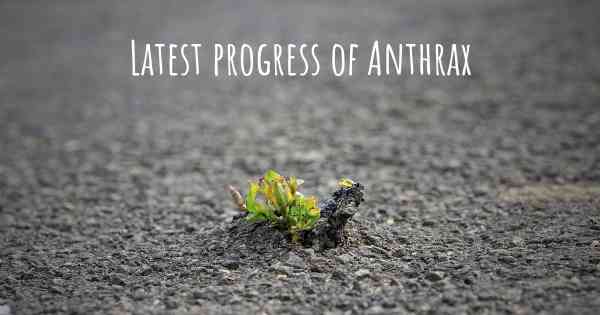What are the latest advances in Anthrax?
Here you can see the latest advances and discoveries made regarding Anthrax.

Anthrax is a highly infectious disease caused by the bacterium Bacillus anthracis. Over the years, significant progress has been made in understanding and combating this deadly pathogen. Ongoing research and technological advancements have led to several breakthroughs in the diagnosis, treatment, and prevention of anthrax.
1. Improved Diagnostic Techniques
Early and accurate diagnosis of anthrax is crucial for effective treatment and containment. Traditional diagnostic methods, such as culturing the bacteria from patient samples, are time-consuming and require specialized laboratory facilities. However, recent advances have introduced more rapid and sensitive techniques.
Polymerase Chain Reaction (PCR) has revolutionized anthrax diagnosis by allowing the detection of specific DNA sequences of B. anthracis. This method enables early identification of the pathogen, even before symptoms appear, facilitating prompt treatment and preventing the spread of the disease.
Biosensors are another promising development in anthrax diagnosis. These devices can detect the presence of anthrax antigens or antibodies in patient samples, providing rapid and on-site results. Biosensors offer portability and ease of use, making them valuable tools in resource-limited settings or during outbreaks.
2. Novel Therapeutic Approaches
Treatment of anthrax typically involves antibiotics, such as ciprofloxacin or doxycycline, which target the bacteria. However, the emergence of antibiotic-resistant strains poses a significant challenge. Researchers are exploring alternative therapeutic strategies to combat anthrax.
Antimicrobial peptides (AMPs) have gained attention as potential therapeutics against anthrax. These small proteins possess broad-spectrum antimicrobial activity and can directly kill bacteria, including B. anthracis. AMPs offer a promising avenue for developing new drugs to overcome antibiotic resistance.
Immunotherapies are also being investigated to enhance the body's immune response against anthrax. Monoclonal antibodies, for instance, can neutralize anthrax toxins and improve survival rates. Additionally, vaccines that stimulate the immune system to produce protective antibodies are being developed to prevent anthrax infection.
3. Advanced Prevention Strategies
Preventing anthrax outbreaks is crucial for public health. Vaccination plays a vital role in protecting individuals at high risk, such as livestock workers or military personnel. Recent advancements aim to improve the efficacy and accessibility of anthrax vaccines.
Next-generation vaccines are being developed to provide enhanced protection against anthrax. These vaccines utilize novel antigen formulations or delivery systems to elicit a stronger and longer-lasting immune response. Furthermore, efforts are underway to develop vaccines that require fewer doses and have improved stability, making them more suitable for mass vaccination campaigns.
Adjuvants are substances that enhance the immune response to vaccines. Researchers are exploring new adjuvants to improve the effectiveness of anthrax vaccines. These adjuvants can stimulate the immune system, leading to a more robust and durable immune response against B. anthracis.
4. Biosecurity and Surveillance
Advancements in biosecurity and surveillance technologies are crucial for early detection and prevention of anthrax outbreaks. These measures help identify potential sources of infection and enable rapid response to contain the spread of the disease.
Genomic sequencing has revolutionized anthrax surveillance by providing detailed information about the genetic makeup of B. anthracis strains. This data helps track the origin and transmission patterns of the bacteria, aiding in outbreak investigations and response planning.
Remote sensing technologies are being utilized to monitor environmental conditions that favor the survival and spread of B. anthracis spores. These technologies enable the identification of high-risk areas, allowing targeted interventions and preventive measures.
In conclusion, ongoing research and technological advancements continue to drive progress in the field of anthrax. Improved diagnostic techniques, novel therapeutic approaches, advanced prevention strategies, and enhanced biosecurity measures are all contributing to our ability to combat this deadly disease. These advancements offer hope for better control and prevention of anthrax, ultimately saving lives and protecting public health.








